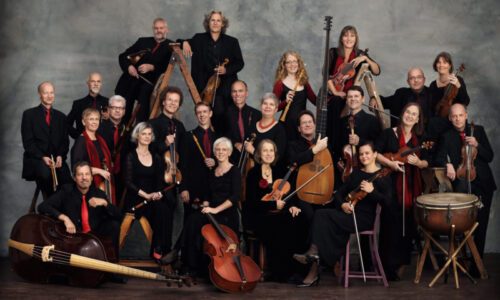 Switzerland Bach: Sunhae Im (soprano), Marie-Claude Chappuis (mezzo-soprano), Benno Schachtner (countertenor), Sebastian Kohlhepp (tenor), Andreas Wolf (bass), RIAS Kammerchor Berlin, Akademie für Alte Musik Berlin / René Jacobs (conductor). Stadtkirche St Johann, Schaffhausen, 29.5.2022. (JR)
Switzerland Bach: Sunhae Im (soprano), Marie-Claude Chappuis (mezzo-soprano), Benno Schachtner (countertenor), Sebastian Kohlhepp (tenor), Andreas Wolf (bass), RIAS Kammerchor Berlin, Akademie für Alte Musik Berlin / René Jacobs (conductor). Stadtkirche St Johann, Schaffhausen, 29.5.2022. (JR)

Bach – Mass in B minor
Schaffhausen is a small, pretty town on the northern fringe of Switzerland bordering southern Germany. It is the site of Europe’s largest waterfall, the Rhine Falls, the home of the International Watch Company (IWC) and the venue for a now biennial prestigious Bach Festival (probably second best-known after that in Leipzig). Covid sadly prevented the Festival taking place over the last couple of years, of course, but now it is back.
The festival always finishes with a flourish, a major Bach work performed by top forces. This year it was the turn of René Jacobs, the RIAS Kammerchor of Berlin and Akademie für alte Musik Berlin. Incidentally, if you are wondering what RIAS stands for (as I was), it is the Radiofunkchor (Radio Choir) In the American Sector, which tells you its origins date from just after the Second World War. There being no concert hall in Schaffhausen, the concert took place in Schaffhausen’s largest church, Kirche St Johann, which was full to the rafters.
René Jacobs, who started off his musical life as a countertenor in Gent, belongs to that small group of renowned Baroque specialists; and the RIAS Kammerchor is surely one of Germany’s finest professional choirs. The performance was undoubtedly of the highest quality but there were intriguing quirks (traditionalists would have found them infuriating).
We began not with the usual choir intonation of ‘Kyrie’ but with some of the sopranos singing a short introduction to the work. My neighbour and I, with our scores in hand, thought we had come to the wrong concert. Soon we were back on track but, oddly, there were passages where the chorus was supposed to sing, and where the soloists took over, and vice versa. It did not help that Jacobs adopted some idiosyncratic placings. He split his into two: Choir I in front of the orchestra, Choir 2 at the back, behind the orchestra; at the end of Part II it was a case of musical chairs and the soloists, who had been at the front, went to the back to mingle (and occasionally sing with) Choir II. One often did not know where to look to see who was singing. No matter, the singing was always of the highest order though with only a handful of singers per part in Choir I and fewer in Choir II, the sound was often too meagre and one yearned for volume. Bach used a Favoritchor of some 16 singers and Jacobs has followed Bach’s example to the letter; some delightful effects were certainly created by this means. However, tutti were broken into two, and the choral thrill of a greater mass of singers was dissipated. Jacobs achieved dynamic shading by increasing or reducing the number of singers he employed, not always successfully. Some of the sound went straight into the roof in the church’s cavernous acoustic.
Jacobs, with few extrovert gestures (he sits to conduct), kept the tempi flowing and the whole work came in at well under two hours. The ‘Gratias agimus tibi’ and ‘Sanctus’ were taken particularly fast: it helps when the choir can tackle tricky coloratura at speed. Last notes of each section were always held very long for effect, showing off the choir’s impressive breath control.
The soloists were all distinguished. The scheduled American soprano Robin Johannsen was replaced at almost the last minute by South Korean soprano Sunhae Im who was bright and light, but rather overshadowed by Swiss mezzo Marie-Claude Chappuis who was simply stunning in ‘Laudamus te’. She smiled winningly throughout, as did we.
The alto part was taken by countertenor Benno Schachtner, who has a lovely, rich tone far removed from the often rather restricted one of some of his competitors. Tenor Sebastian Kohlhepp is clearly a rising star; Andreas Wolf, German bass, will also have a fine career ahead of him.
‘Cum Sanctu spiritu’ was thrilling; ‘Osanna’ was suitably uplifting. I would have liked more heft in the ‘Credo’. The soloists took the ‘Crucifixus’ which gained in transparency but rather lacked bite. It did however make a fine contrast to the exhilarating ‘Et resurrexit’.
The orchestra stood throughout, which certainly brought an air of immediacy to the performance. Solos were first-rate though the valveless horn player had to fight, albeit valiantly, with his instrument at times in the ‘Quoniam’ section. One of the bouncier violinists forgot that frequent vibrato had not yet become fashionable in the 1750s. Woodwind were particularly impressive.
‘Dona nobis pacem’ concluded the work beautifully, the whole choir and soloists sending a clear topical message of peace to the world. This was a fine, if quirky B minor Mass but one which will stay in the memory.
Jacobs has very recently recorded this work for Harmonia Mundi with this choir and orchestra. He used the same tenor (Kohlhepp), the same mezzo (Chappuis), the soprano who was supposed to have sung in Schaffhausen (Johannsen), and a different countertenor and bass. Do hear it if you are tempted by my review; but it is a somewhat individualistic version of this great work.
Finally: a date perhaps to save in your diary: 12 May 2024. Czech orchestra and choir Collegium 1704 will perform Bach’s Mass in B minor at the Festival under their founder Václav Luks.
John Rhodes
